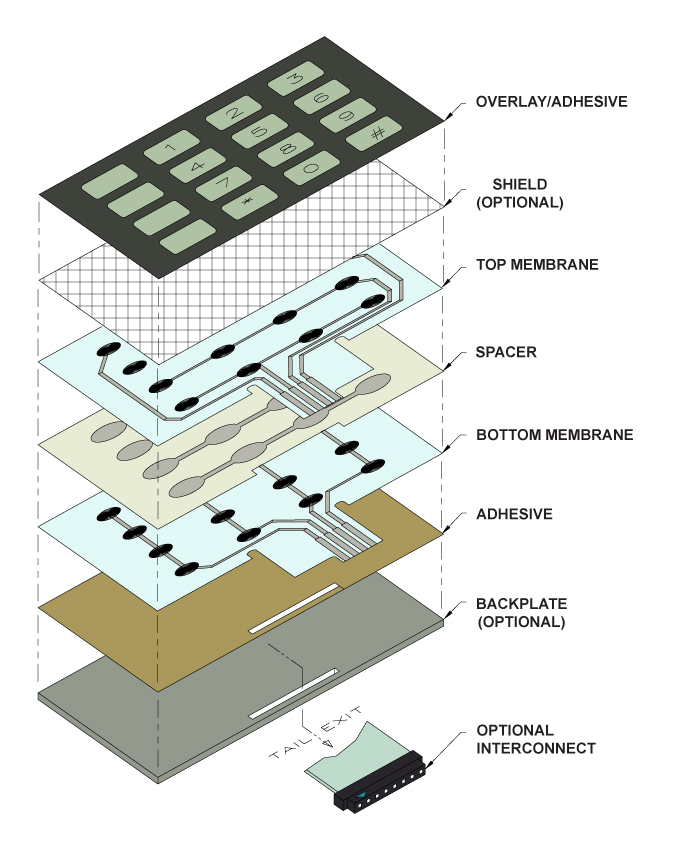Membrane Switch Innovation: The Trick to Trusted and Cost-Effective Interfaces
Membrane switch modern technology has actually emerged as a critical component in the style of user interfaces, giving both integrity and cost-effectiveness throughout a diverse variety of applications. As we explore the diverse advantages of membrane switches, their potential for innovation elevates concerns regarding future applications and evolving patterns.
Comprehending Membrane Layer Switch Over Innovation
Membrane button technology is an extensively utilized user interface service in different electronic tools, providing a smooth blend of capability and design. This technology incorporates numerous layers of products, usually consisting of a graphic overlay, spacer layer, and a circuit layer. The visuals overlay displays the user interface components, while the spacer layer separates the circuit layer from the overlay up until a customer activates a button.
When stress is related to the overlay, the circuit layer completes the electrical circuit, sending a signal to the tool. This device allows for numerous configurations, including tactile comments and backlighting options, enhancing user interaction. Membrane layer switches are typically produced making use of sturdy materials such as polyester or polycarbonate, ensuring long life and resistance to environmental variables like moisture and dust.
The versatility of membrane switches enables their application in diverse sectors, consisting of clinical gadgets, customer electronic devices, and industrial controls. Their small design permits integration into space-constrained environments, giving a reliable interface without compromising aesthetic allure. Recognizing the details of membrane layer button modern technology is crucial for producers and developers looking for to develop trusted and reliable human-machine interfaces.
Trick Advantages of Membrane Layer Switches
While numerous user interface options exist, membrane switches over offer distinctive benefits that make them a recommended selection in many applications. Among the main advantages is their longevity; membrane buttons are created to stand up to harsh ecological problems, including dampness, dust, and temperature level fluctuations, making certain lasting efficiency. This durability dramatically lowers the requirement for constant substitutes, therefore lowering overall upkeep expenses.

Additionally, membrane buttons are light-weight and portable, making them appropriate for applications where area is restricted. Their low-profile design adds to a smooth look without compromising performance.
Cost-effectiveness is also a significant benefit, as the production procedure for membrane changes tends to be more economical compared to typical mechanical buttons. This affordability, integrated with their dependability and ease of installment, settings membrane switches over as a sensible solution for a large range of markets seeking reliable and efficient user interfaces.
Applications Across Various Industries
How do membrane switches adjust to the varied needs of different industries? Membrane switch innovation is progressively identified for its versatility, making it ideal for a vast range of applications throughout several fields.
In consumer electronics, membrane switches offer a compact service for push-button controls and home devices, boosting customer experience through intuitive design. Additionally, the commercial sector leverages membrane layer switches for equipment control board, gaining from their resistance to rough atmospheres, such as dampness and dust.
Military and aerospace applications also utilize membrane layer switches for their reliability and capability to withstand extreme problems, making certain operational efficiency in essential scenarios. The food and drink market takes on these switches for automated systems, where cleanliness and simplicity of operation are extremely important (membrane switch). Inevitably, membrane switches are tailored to fulfill the distinct needs of site web each industry, showing their crucial duty in contemporary technology interfaces
Design and Customization Options

In the world of membrane layer switch modern technology, style and personalization options play a crucial duty in improving functionality and customer communication. These switches can be customized to meet details operational needs and aesthetic choices, making them functional parts in various applications.
Among the primary customization choices is the design of the button itself, which can be developed to fit one-of-a-kind interface and ergonomic considerations. By adjusting the shape, size, and plan of buttons, producers can produce intuitive designs that help with simplicity of use. Additionally, the consolidation of various shades and visuals overlays allows for branding and enhanced visibility, making sure that users can promptly identify functions.
Furthermore, membrane switches can be crafted with different responsive comments mechanisms, such as increased buttons or audible clicks, to boost the customer experience. over here Various products can also be selected for longevity and ecological resistance, resolving variables such as wetness, temperature level variations, and chemical exposure.
Inevitably, the considerable layout and personalization options available in membrane layer button technology empower businesses to develop tailored services that not only fulfill useful requirements yet additionally line up with their branding and operational requirements.

Future Trends in Membrane Layer Buttons
As you can try these out membrane layer button technology remains to progress, future fads are significantly focused on boosting customer experience and integrating innovative performances. One substantial trend is the assimilation of touch-sensitive and capacitive innovations into typical membrane switches. This development enables more user-friendly interface, giving responsive comments while keeping a smooth style.
Another emerging pattern is the usage of eco-friendly materials, driven by the growing need for lasting manufacturing practices. Producers are looking for to lower their carbon impact by using recyclable substratums and low-impact inks, aligning with international sustainability objectives.
Moreover, the rise of the Internet of Points (IoT) is prompting the incorporation of smart attributes right into membrane switches. Boosted connectivity options will enable devices to interact with each other, enabling seamless assimilation into wider systems.
Furthermore, developments in printing innovations, such as digital printing, are enabling greater design adaptability and personalization. This allows makers to create intricate designs and vivid shades cost-effectively.

Final Thought
In final thought, membrane switch technology stands for an essential technology in customer interface layout, supplying substantial benefits in toughness, modification, and cost-effectiveness. As advancements continue to emerge, especially in touch-sensitive interfaces and lasting products, the capacity for membrane layer switches over to improve user experience and capability stays promising.